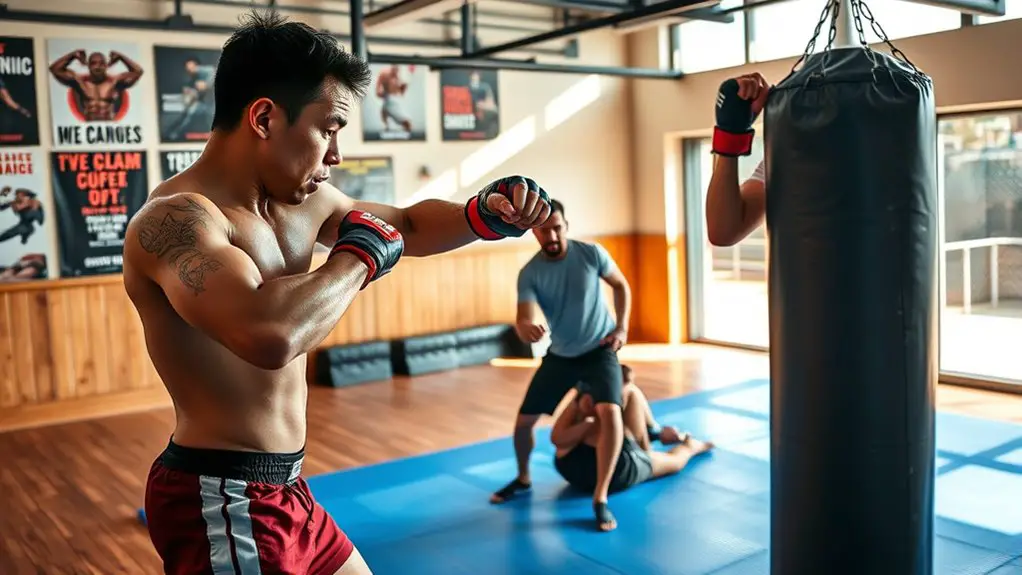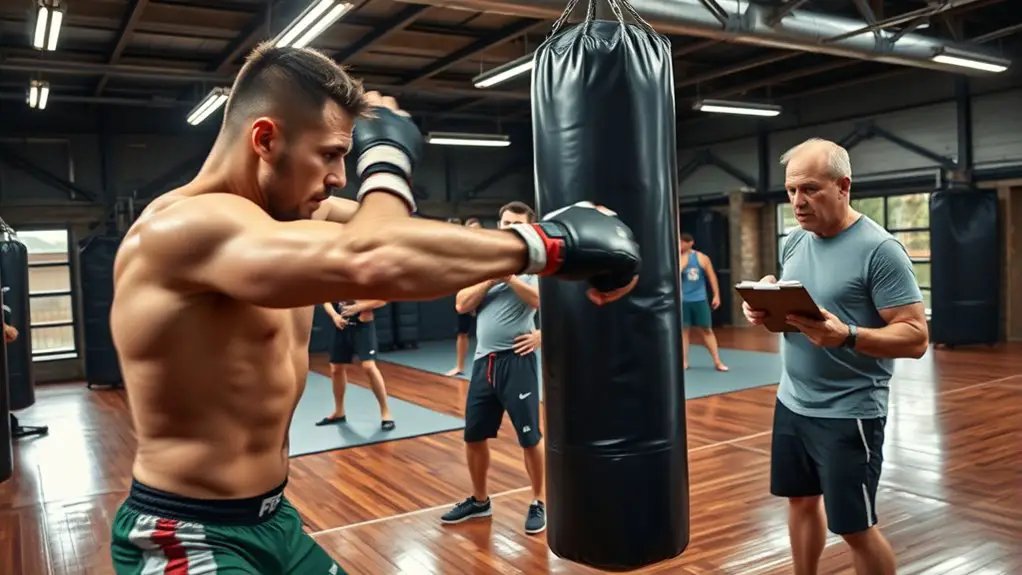How to Train Like an MMA Fighter in the Gym

To train like an MMA fighter in the gym, focus on mastering technical skills like striking and grappling while incorporating strength and conditioning. Mix cardio workouts, such as interval training and agility drills, with functional strength exercises. Prioritize safety, recovery, and nutrition to support muscle repair and overall performance. Set realistic goals and track your progress to stay motivated. There’s plenty more to explore about enhancing your training and achieving your MMA aspirations.
Understanding MMA Training Basics

When you immerse yourself in MMA training, it’s essential to grasp the fundamentals that set the foundation for your success. Understanding MMA history can provide valuable insights into why certain techniques and strategies are emphasized today. This sport evolved through various martial arts, and knowing its origins helps you appreciate the training philosophy behind each discipline you’ll encounter.
Safety should always be your priority. Start with basic techniques, focusing on proper form and control. Whether you’re learning striking or grappling, make sure you’re practicing with a partner who shares your commitment to safety. Use protective gear to minimize the risk of injury during training sessions.
Lastly, remember that consistency is key. Develop a regular training schedule that balances skill work, conditioning, and recovery. This thoughtful approach will not only enhance your skills but also keep you safe as you progress in your MMA journey.
Incorporating Cardiovascular Conditioning
To excel in MMA, you can’t overlook the importance of cardiovascular conditioning, as it plays an essential role in your overall performance. Incorporating interval training into your routine is a great way to boost your stamina and heart rate efficiently. Try mixing high intensity intervals with steady-state aerobic conditioning during your endurance workouts. For example, you can alternate between sprinting and jogging or integrate cardio circuits that involve various exercises like burpees, jump rope, and shadowboxing. These methods not only enhance your cardiovascular fitness but also contribute to functional fitness, allowing you to perform better during fights. Be mindful of your heart rate, ensuring it stays within a safe range while pushing your limits. Remember, consistency is key for stamina building, so aim to include these cardiovascular sessions several times a week for ideal results. Additionally, incorporating jump rope workouts can significantly improve your agility and coordination, crucial for striking and movement in the octagon.
Building Functional Strength

Building functional strength is essential for any MMA fighter looking to enhance performance in the cage. This type of strength focuses on movements that improve your functional mobility while ensuring safety during training. Incorporating exercises that mimic the actions of fighting can help you develop the necessary strength while minimizing injury risks.
Here’s a quick guide to effective strength training exercises:
| Exercise | Benefits |
|---|---|
| Deadlifts | Builds overall strength |
| Kettlebell Swings | Enhances hip explosiveness |
| Bodyweight Squats | Improves leg power |
Utilizing these exercises, you’ll not only strengthen your core and limbs but also improve coordination and balance. Remember, quality over quantity is key—focus on proper form to maximize your results and reduce the chance of injury. Stiff leg deadlifts effectively target hamstrings, making them a great addition to your routine. Get ready to take your training to the next level!
Developing Agility and Speed
While strength is essential, agility and speed are equally important for an MMA fighter. To enhance these attributes, it’s vital to incorporate specific training into your routine. Start with agility drills like ladder exercises, cone drills, or shuttle runs. These activities improve your footwork and coordination, helping you evade opponents effectively.
For speed training, focus on short sprints and explosive movements, such as jump squats or plyometric push-ups. These exercises not only build quickness but also strengthen your muscles in a functional way. Additionally, incorporating jump rope techniques into your routine can further enhance your agility and overall cardiovascular fitness. Remember to prioritize safety; warm up properly before starting any drills and listen to your body to avoid injuries.
Mastering Striking Techniques

To truly master striking techniques, you need to focus on essential fundamentals that build your skills. Shadowboxing and bag work are key practices that help you refine your technique and improve your power. Let’s explore how these components can elevate your striking game.
Essential Striking Fundamentals
Mastering striking techniques is essential for anyone looking to excel in MMA. Start by focusing on fundamental striking combinations that allow you to deliver effective punches and kicks while maintaining balance. It’s vital to practice these combinations repeatedly, ensuring you’re comfortable and precise with each move. Equally important are your defensive maneuvers; learn how to slip, block, and counter effectively to protect yourself during sparring sessions. Remember, safety should always be your priority. As you train, pay attention to your form and avoid overextending, which can lead to injury. By combining well-practiced striking techniques with solid defensive tactics, you’ll build a strong foundation for your MMA journey. Stay focused and train smart!
Shadowboxing and Bag Work
Shadowboxing and bag work are essential components of developing your striking skills in MMA. These practices not only improve your techniques but also enhance your footwork and timing. When shadowboxing, focus on proper form and incorporating various shadowboxing techniques to simulate real fight scenarios. Bag work drills can help reinforce power and accuracy.
Here’s a quick overview of effective exercises:
| Exercise | Focus Area | Duration |
|---|---|---|
| Shadowboxing | Technique & Flow | 3 rounds (3 min each) |
| Heavy Bag Strikes | Power & Precision | 5 rounds (2 min each) |
| Speed Bag | Coordination | 3 rounds (2 min each) |
| Body Shots | Accuracy | 4 rounds (1 min each) |
| Combination Work | Strategy | 3 rounds (2 min each) |
Stay safe, and remember to warm up before starting!
Learning Grappling and Groundwork
When it comes to grappling and groundwork, mastering essential techniques is key to your MMA success. You’ll want to focus on drilling partner exercises to build your skills and improve your overall game. This foundation will not only enhance your grappling but also prepare you for the unpredictability of a fight.
Essential Techniques Overview
Grappling and groundwork are essential components of MMA that can greatly enhance your fighting skills. You’ll want to focus on mastering techniques like positional control, escapes, and submissions to keep your training safe and effective. Start by incorporating various grappling shifts, which will help you move fluidly between different positions. These shifts are crucial when countering striking combinations or attempting to take your opponent to the ground. Practicing these techniques with a partner allows you to develop timing and sensitivity while minimizing the risk of injury. Remember, safety is key—always train at a controlled pace and communicate with your training partner. By honing your grappling skills, you’ll build a solid foundation for your overall MMA proficiency.
Drilling Partner Exercises
Effective drilling partner exercises are essential for mastering grappling and groundwork in MMA. These partner drills help you refine your techniques while ensuring safety for both you and your partner. Always communicate clearly about movements and intensity to avoid injuries.
| Exercise | Focus Areas |
|---|---|
| Guard Passing | Positioning & Control |
| Takedown Defense | Balance & Reaction |
| Mount Escapes | Timing & Escape Techniques |
| Submission Drills | Technique Refinement |
| Sweeps & shifts | Fluidity & Movement |
Engaging in structured partner drills not only enhances your skills but also builds trust and teamwork. Remember to keep safety as your priority, adjusting your pace and intensity based on your partner’s comfort level.
Implementing Recovery and Nutrition
While you train hard to build strength and skills like an MMA fighter, neglecting recovery and nutrition can undermine your efforts. Incorporating effective recovery strategies is essential for preventing injuries and ensuring your body heals after intense workouts. Aim for adequate sleep, hydration, and active recovery days to keep your muscles fresh and ready for action.
Nutrition timing is equally important. Fuel your body before training with a balanced meal or snack rich in carbohydrates and protein to maintain energy levels. Post-workout, focus on recovery meals that include protein and healthy fats to support muscle repair. Don’t forget to listen to your body; if you’re feeling fatigued, it’s okay to take a step back and prioritize rest. By implementing these recovery and nutrition practices, you’ll enhance your performance and keep your training sustainable and safe.
Setting Realistic Goals and Tracking Progress
How can you guarantee that your training is both productive and purposeful? Start by implementing effective goal setting strategies. Set specific, measurable, achievable, relevant, and time-bound (SMART) goals that align with your MMA aspirations. This helps you focus on what you want to achieve while ensuring your objectives are realistic and safe to pursue.
Next, incorporate progress tracking methods to monitor your advancements. Use a training journal or apps to log workouts, techniques learned, and physical changes. Regularly review your progress to identify strengths and areas needing improvement, adjusting your goals as necessary.
Frequently Asked Questions
Do I Need Prior Experience to Train Like an MMA Fighter?
You don’t need to be a seasoned warrior to start training like an MMA fighter. Just like Rocky didn’t win on day one, you can begin without prior skills. What you really need is a dedicated training mindset and a willingness to learn. Remember, safety’s key—listen to your body and don’t rush the process. With patience and perseverance, you’ll build your skills and confidence, transforming into a fighter in your own right.
What Gear Is Essential for MMA Training in the Gym?
When you’re gearing up for MMA training, having the essential equipment is vital for your safety and performance. You’ll need gloves, shin guards, and a mouthguard to protect yourself during sparring. Quality training apparel, like moisture-wicking shirts and shorts, keeps you comfortable while you move. Don’t forget hand wraps for wrist support and a durable gym bag to carry your gear. Investing in the right equipment makes a big difference in your training experience.
How Often Should I Train per Week for Optimal Results?
You might be wondering just how often you should train for ideal results. The answer isn’t as straightforward as you’d think. Training frequency is vital, but so is recovery importance. Aim for 3 to 5 sessions per week, depending on your experience. Listen to your body; if you’re feeling fatigued or sore, don’t hesitate to take a rest day. Balancing intensity with proper recovery will keep you safe and help maximize your progress.
Can Women Train Like MMA Fighters and Compete?
Absolutely, women can train like MMA fighters and compete! It’s all about women empowerment and embracing your competitive spirit. Training can boost confidence and skills while ensuring safety through proper techniques and supervision. You’ll find a supportive community that encourages growth and resilience. With dedication and the right mindset, you can thrive in this challenging sport, breaking barriers and showing that strength knows no gender. So, get ready to release your potential!
What Are the Risks of Training Like an MMA Fighter?
Training like an MMA fighter can lead to several risks, including injuries from intense workouts and sparring. To minimize these risks, you’ll want to prioritize injury prevention techniques such as proper warm-ups and using protective gear. Incorporating effective recovery strategies, like stretching and adequate rest, is essential for keeping your body in shape. Always listen to your body and don’t push through pain; safety should be your top priority while training.





